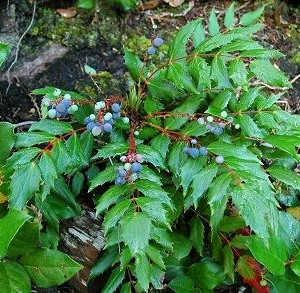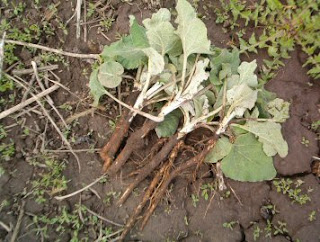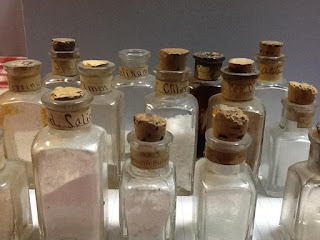HERBS, BUGS AND BARNACLES
An antique collection of 84 samples from an old Montana pharmacy
By Merry Lycett Harrison, RH (AHG)
Out of curiosity, I occasionally visit ebay, the
online auction site, and type in the word “herbs” in the search box. Usually, I
see the ubiquitous weight loss combinations, books, pretty tea towels and canister
sets. Last time, however, “Herbalist Collection of Herbs CA. 1920“caught my
eye. A seller in Montana
was offering 6 small boxes that held one dried herb each. Digital pictures
showed the contents of each open box. The six herbs represented were golden
seal, cascara sagrada, buckthorn bark, cola nut, cotton root bark and
sassafras. There was another photo of the six box lids. Each had lots of tiny
writing on it. This legible script listed the botanical name, the common
name(s), the plant part within the box, A.C. (active constituents), use, a
description of the appearance, characteristics, taste and preparation. All this
handwriting was in a 2”x 3” space. Judging from the style of writing, the
condition of the boxes and vocabulary used, it appeared that they were old. I
was fascinated.
I
contacted the seller to learn more about them, and he said they had come out of
an old pharmacy in a small town near the Continental Divide on the edge of the Bitterroot Forest
in Montana.
The owner of the pharmacy was retiring and was selling off some things. He told
the seller that these little boxes were there when he bought the business forty
years ago. “Were there any more of them?” I asked. “Yes, lots”, he replied.
The seller was intending to sell the
little boxes off a few at a time. I immediately thought that it would be a
shame if the collection was broken up. From the little I knew, I had a hunch
that the boxes held specimens of herb samples that were used in the old
pharmacies. The kind that had a fountain that served up tasty soda tonics for
whatever ailed you. As an herbal instructor, I thought, at the very least, they
might be a good teaching tool. I was able to contact the retiring pharmacist,
and he mentioned that they may have been used for just that very purpose but
knew little else about the collection.
I asked the seller if he would consider
selling the lot to me, and we settled on a price. He assured me the only ones
that had been separated from the collection were the six on ebay. Though I had lost
the bid, I kept a record of the boxes that sold along with the photos of them.
When the shipment arrived, I was not
disappointed. There were 78 boxes in all, just like the ones that had been
shown on ebay. I spent hours looking them over, needing a magnifying glass to
see some of the minute writing. Some of the herbs seemed very familiar, obvious
essentials for any herbal pharmacy. Others were totally unfamiliar to me like
alkanet root, Alkanna. This small,
twisted, red root was used as a coloring agent in ointments the box top said.
Some boxes did not even have
plant material in them. One contained insects, Cochineal, an insect that lives
on cactus that was used as a coloring agent. Another box contained barnacles
off of whales that were apparently used to thicken rose water ointments. One
box held beeswax.
In order to organize what I had, I set the
boxes in alphabetical order and transcribed all the writing to try to make some
assessment. In doing so, I have enjoyed researching some of the more unusual
materials and descriptions in hopes that there will be clues as to how old this
collection is. There are many “purgatives” and flavoring agents like mints,
citrus, saffron, anise, nutmeg, ginger, cardamom, and bitter apple, many of
which were listed as carminatives too. I was surprised to read that one of the
uses for slippery elm was “abortion” as well as the familiar “demulcent,
emollient”.
Some boxes listed pharmaceutical products
that contained the herb within it like psyllium seed (Plantago simin). A Parke Davis product called Siblin was noted on
the box. Though there is a lot of valuable information on each box, there is
much that is quaint and old fashioned about the language and terms. I have
transcribed it all as the words appear, grammatical errors, abbreviations, and misspelled
words, of which there are many.
RESEARCH
In my continuing quest to place the
collection in a chronological context, I contacted Maggie Heran, Director of
the Lloyd Library and Museum, in Cincinnati.
Through phone conversations, emails and faxes, we began piecing together
information trying to determine the collection’s age and use. She has shared very
interesting articles she has discovered about such collections and copies of
prints of pieces of furniture from circa 1899 offered by Parke Davis & Co.
that were made to hold such samples. “Only by carefully examining and handling
specimens can a student of pharmacy familiarize himself with the properties of
drugs.” reads an 1897 description of the collection’s purpose.
In an article about artifacts from the International Journal of Pharmaceutical
Compounding (Vol. 8 No. 5) titled “American Institute of the History of
Pharmacy, Madison Wisconsin,” by Lloyd scholar, Dennis B. Worthen, PhD, he
writes about the specimen cabinets. “One of the more unusual items is a
complete Parke Davis and Company cabinet of materia medica samples. These small
tin boxes have a glass window in the lid for visitors to view the contents. The
specimens were used by students to learn the botanicals and their parts, the
mainstay of therapeutics throughout the early part of the 20th
century.” Ms. Heran found the listing of the inventory and there are 288
specimens.
Another interesting piece of Heran’s
research at the Lloyd Library turned up an 1890 copy of “Lilly’s Bulletin” from
Eli Lilly & Company which offered its own, scaled-down, less expensive
version of “Student’s Collection of Official Organic Drugs.” The description
reads,
“Students of medicine and pharmacy feel the need of a
collection such as we offer. Those now found upon the market are quite
expensive, or if not so are undesirable owing to careless collection or faulty
packages.
To meet a
demand we have prepared under expert supervision of our botanical department a
substantial case containing 172 specimens of official organic drugs. Each
specimen is so arranged as to show the characteristics of the drug. The boxes
bear numbers only, a key for identification being provided.
In order to
bring within reach of a large number of students we bring the low price of $10.
As this is intended for students only, we provide no profit for druggists, but
make the same price to all.”
In the pictures of fixtures
that stored these collections there is one very modest cabinet called “Mulford’s
Compressed Tablet Case”, and it looks like it holds at least 84 small boxes.
Eli Lilly Co. and John Wyeth & Bro. offered similar cabinets. Could these
boxes have been a scaled down collection that could be stored in such a
cabinet? Why the handwritten lids? Did someone painstakingly copy the printed
versions and take a bit of the herb in each box to provide specimens to a pharmacy
in a remote Montana
town?
And what of the town that the
collection came from? It came out of the oldest pharmacy in the oldest town in Montana. The pharmacy is
now called Valley Medical Supply. Stevensville is a small town brought up
around the old St. Mary’s Catholic Mission. Its history is very rich, and the
people of Stevensville, obviously proud of their heritage, could not have been
more helpful in directing me to historians who I could contact about my
research. In a lengthy conversation with
Colleen Meyer, Director of Historic St. Mary’s Mission, she explained details about its
history. Italian priest, Father Antonio Ravalli, ran the mission from
1845-1884. He was himself a physician, pharmacist, architect, machinist, and
sculptor who befriended, ministered to and traveled great distances to heal and
serve the Native American community. It is said he had the first “ride up
window” to his small dispensary that is still standing at the mission today.

I asked her if there might be anything in
their antique collections from the 1920 period that might be useful in learning
more about the collection. She mentioned that the people at Valley Drug and
Variety had contributed an old book or ledger to the mission. I asked her to
look inside it to see what it said. Through email she informed me that the book
was a prescription book from the old Stevensville Drug Company that dated from
March to May of 1908. There was even a name, “Joe Dagenais, Reg. Pharmacist.” I
sent a picture of the writing on the boxes to Colleen to see if she could
compare the hand writing. In 1920 the town of Stevensville was a small agricultural
community, not a boom town of mining or lumber, so it is fitting that this herb
collection is homemade and modest.
Conversations with Michael Moore, 11/9/05, 12/6/05.
After sending my herb teacher, Michael
Moore, a few pictures of the boxes and the transcription via email, we spoke on
the phone. Michael is the director of the Southwest School of Botanical
Medicine in Bisbee, Arizona (www.swsbm.com). Being a scholar of
the history of botanical medicine, he had many insights into the purpose, use
and period of the collection.
The first thing he said was that this was
a homemade “self-teaching kit” for a student of pharmacy from the era of
between 1915 and 1925. The handsomely designed collection of 288 specimens
offered by Parke Davis circa 1899 (see picture) cost $25 which was about four
months wages, according to Michael, so it would seem this collection was
created by someone of modest means.
He explained that until the 1920s, unless
you attended the school of Pharmacy in Philadelphia,
most students learned the profession by apprenticing for between 3-5 years with
a professional pharmacist and home study. The student might have lived with the
family above the pharmacy, and after the apprenticeship, could travel to a
school, the closest one being in St. Lewis, to complete the education with a
few courses before sitting for the board exam to certify or qualify as an RP or
Resident Pharmacist. Then again, if the community was in need of a pharmacist
in an area far from cities where such education could be obtained, the student
might forgo the exam and the expense of it and go right to practicing pharmacy.
The student may have obtained a diploma from the pharmacist he apprenticed
with.
When I commented that the useful medicinal
plants of the Bitteroots were conspicuously absent, he fired back, “The
collection is strictly pharmaceutical and has nothing to do with regionalism!
It is an accurate representation of plants of the USP, United States
Pharmacopeia, and NF, National Formulary.” He explained that students of
pharmacy needed to learn the plants physically for a few reasons. First, by
learning to identify the plant, they would have a discerning eye to know if an
order received from afar was quality material and exactly the right plant and
correct part of the plant. The pharmacist could use these samples in the boxes
for comparison. Secondly, it was more profitable when the pharmacist made and
compounded the medicine he sold so it was necessary to be extremely familiar
with the plant material.
As we scrolled through the transcription
together reading the language on the boxes, we studied “Cambogia” or “Gamboge”.
Michael thought I was mispronouncing the word, and I was thinking that perhaps
the ink on the box had faded with age so the C should be written like a G. I
double checked the box and told him I thought the transcription was accurate.
He took a moment to look it up in Culbreth’s Manual of Materia Medica and Pharmacology, and remarked that the
name, “Cambogia” was not in use after 1926. The last line on the box reads,
“Prep- in C.C. pills”. I asked what C.C. stood for, and by once again skimming
through his resources he knows so well, he found that it stood for “Cathartica
Compositae”. Translation, “bowel ripper” he said. He also noticed that the term
Calabar Bean, Physostigma venenosum ,
fell out of favor before 1920. This helped us to place a date for the collection.
I was perplexed why some listings include
a pharmaceutical company’s name, such as psyllium which reads, “Prep- Parke
Davis Siblin” or Karaya Gum which reads,” Prep-squibs Granaya &
cascara-savaka”. Michael said that pharmacists would buy a few premade
preparations of what they most commonly used or ones that were too toxic or
difficult to manufacture themselves like opium, digitalis and cannabis. He said
that with opium, it was hard to get the crude drug, and digitalis preparations
had to be tested for potency on animals. He said that opium and cannabis were
the most adulterated of the day.
As to why there are so many spelling and
grammatical errors, he commented that like today, some people’s education was
limited and they just did not know how. There are so many misspellings, he
seemed sure I had read the letters wrong, but we agreed that it just added to
the character of the collection.
When Michael learned that the collection
had come out of an old pharmacy in Stevensville, he recalled that the very
famous homeopathic physician, James Tyler Kent, M.D, (1849-1916) had retired
there. After having lectured in Europe and the U.S. we wondered what drew him
there and also whether he was in any way associated with the pharmacy.
In my second interview with Michael, I
prepared by going over the transcription carefully and noting terms, uses,
anything that seemed unusual or not clear to me. I tried to do my homework
before calling to answer as many questions for myself by using his extensive
resources and library of Eclectic Materia Medicas and manuals which he offers
in a 2 CD set. It was a rich educational opportunity for me to peruse these
texts seeking specific information. Culbreth, Petersen, Sarye’s all had
something I was looking for.
In our further discussion, I asked why the
value of “Cactus Grandiflorus” (Cereus) was
listed as “doubtful”. “The plant was in and out of favor for 100 years”, he
said. In that era, he explained, they made preparations from dried, expressed
juice which is useless. It is only the preparation from the fresh plant that is
useful and this preparation was widely used by the eclectics. He claimed, “It
is the difference between the vitalist and mechanist approach”.
Under Capsicum,
Cayenne, it
reads, “Color-red-odor-charact. & stornatatory”. Michael set me straight by
explaining, “Is is sternatory, s-t-e-r-n-a-t-o-r-y. Makes you sneeze.” Reading
it over again, I realize it serves as a warning to the pharmacist when testing
the material rather than a therapeutic recommendation.
Crocus was used to treat the measles?
“Yes”, he said, “it was used as an alterative to stimulate eruptions”. It was
the idea at the time that the sooner the illness worked its way out the faster
a person would get well. “The same for chickenpox,” he said.
Hematoxylon,
log wood’s, use was listed “as a dye and as a quanlitation indicator in
alkaloidal assays”. He had no clue what that was and we moved on. Karaya gum
from Cochlospermum gossypium is
listed. He claimed it was an old fashioned preparation.
The listing I most wanted an explanation
for was under Ulmus, slippery elm.
Under “Use” it read “abortion, demulcent, emollient”. I had looked through the
manuals and did not see any such reference for abortion. Yes, he knew all about
this too. “A branch of the tree was inserted into the cervix, disturbing the
uterine lining as the mucilaginous inner bark softened.” He explained that this
is part of “women’s medicine” that one finds in such older texts.
CONCLUSION
Though
there are still interpretations to be made, abbreviations and terms to be
understood, and language to be scrutinized, I believe that Maggie Heran’s
helpful research and Michael Moore’s informed perspectives unlock the mystery
of this collection. His analysis dates the collection to before 1920. It is not
known how complete the collection is, but it certainly holds a broad selection
of not only the herbs that are essential to an early pharmacy but others that
place it in historical context.
To view more photos of the
boxes and their contents visit the Articles&Research page at http://www.millcreekherbs.com/research.html.


























